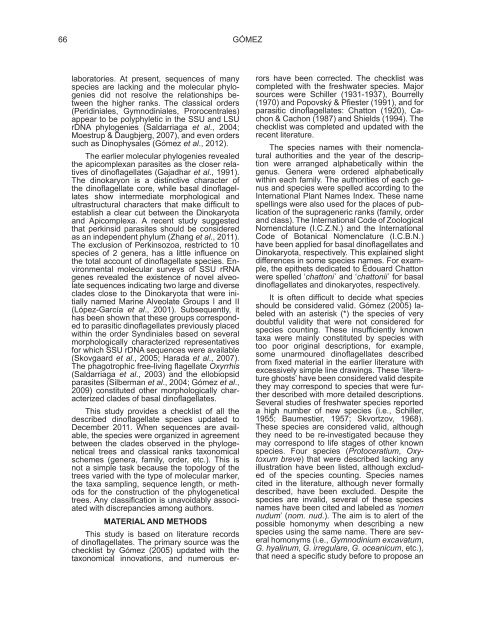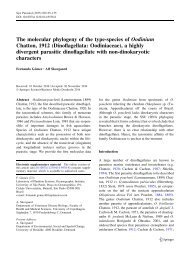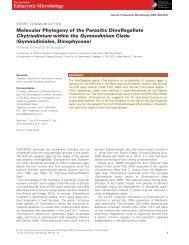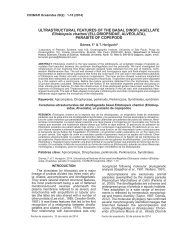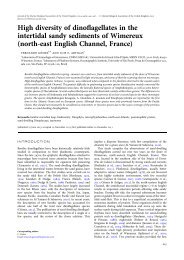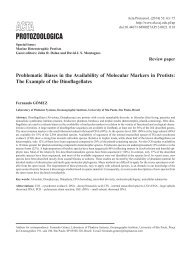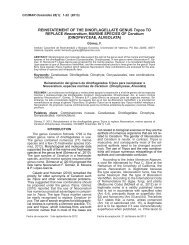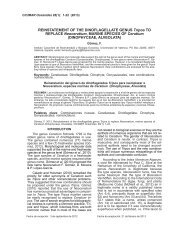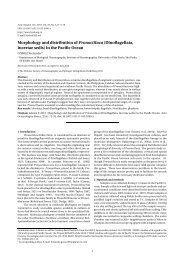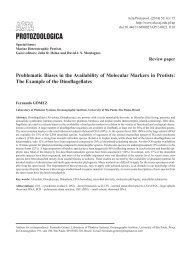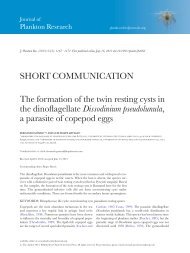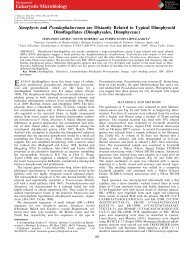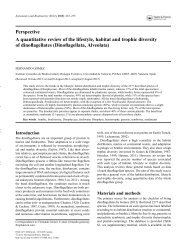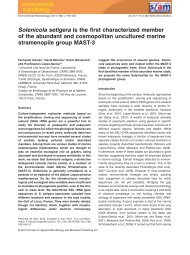A CHECKLIST AND CLASSIFICATION OF LIVING DINOFLAGELLATES (DINOFLAGELLATA, ALVEOLATA)
A checklist and classification of the extant dinoflagellates are given. Dinokaryotic dinoflagellates (including Noctilucales) comprised 2,294 species belonging to 238 genera. Dinoflagellates sensu lato (Ellobiopsea, Oxyrrhea, Syndinea and Dinokaryota) comprised 2,377 species belonging to 259 genera. The nomenclature of several taxa has been corrected according to the International Code of Botanical Nomenclature. When gene sequences were available, the species were classified following the Small and Large SubUnit rDNA (SSU and LSU rDNA) phylogenies. No taxonomical innovations are proposed herein. However, the checklist revealed that taxa distantly related to the type species of their genera would need to be placed in a new or another known genus. At present, the most extended molecular markers are unable to elucidate the interrelations between the classical orders, and the available sequences of other markers are still insufficient. The classification of the dinoflagellates remains unresolved, especially at the order level.
A checklist and classification of the extant dinoflagellates are given. Dinokaryotic dinoflagellates (including Noctilucales) comprised 2,294 species belonging to 238 genera. Dinoflagellates sensu lato (Ellobiopsea, Oxyrrhea, Syndinea and Dinokaryota) comprised 2,377 species belonging to 259 genera. The nomenclature of several taxa has been corrected according to the International Code of Botanical Nomenclature. When gene sequences were available, the species were classified following the Small and Large SubUnit rDNA (SSU and LSU rDNA) phylogenies. No taxonomical innovations are proposed herein. However, the checklist revealed that taxa distantly related to the type species of their genera would need to be placed in a new or another known genus. At present, the most extended molecular markers are unable to elucidate the interrelations between the classical orders, and the available sequences of other markers are still insufficient. The classification of the dinoflagellates remains unresolved, especially at the order level.
Create successful ePaper yourself
Turn your PDF publications into a flip-book with our unique Google optimized e-Paper software.
66 GÓMEZ<br />
laboratories. At present, sequences of many<br />
species are lacking and the molecular phylogenies<br />
did not resolve the relationships between<br />
the higher ranks. The classical orders<br />
(Peridiniales, Gymnodiniales, Prorocentrales)<br />
appear to be polyphyletic in the SSU and LSU<br />
rDNA phylogenies (Saldarriaga et al., 2004;<br />
Moestrup & Daugbjerg, 2007), and even orders<br />
such as Dinophysales (Gómez et al., 2012).<br />
The earlier molecular phylogenies revealed<br />
the apicomplexan parasites as the closer relatives<br />
of dinoflagellates (Gajadhar et al., 1991).<br />
The dinokaryon is a distinctive character of<br />
the dinoflagellate core, while basal dinoflagellates<br />
show intermediate morphological and<br />
ultrastructural characters that make difficult to<br />
establish a clear cut between the Dinokaryota<br />
and Apicomplexa. A recent study suggested<br />
that perkinsid parasites should be considered<br />
as an independent phylum (Zhang et al., 2011).<br />
The exclusion of Perkinsozoa, restricted to 10<br />
species of 2 genera, has a little influence on<br />
the total account of dinoflagellate species. Environmental<br />
molecular surveys of SSU rRNA<br />
genes revealed the existence of novel alveolate<br />
sequences indicating two large and diverse<br />
clades close to the Dinokaryota that were initially<br />
named Marine Alveolate Groups I and II<br />
(López-García et al., 2001). Subsequently, it<br />
has been shown that these groups corresponded<br />
to parasitic dinoflagellates previously placed<br />
within the order Syndiniales based on several<br />
morphologically characterized representatives<br />
for which SSU rDNA sequences were available<br />
(Skovgaard et al., 2005; Harada et al., 2007).<br />
The phagotrophic free-living flagellate Oxyrrhis<br />
(Saldarriaga et al., 2003) and the ellobiopsid<br />
parasites (Silberman et al., 2004; Gómez et al.,<br />
2009) constituted other morphologically characterized<br />
clades of basal dinoflagellates.<br />
This study provides a checklist of all the<br />
described dinoflagellate species updated to<br />
December 2011. When sequences are available,<br />
the species were organized in agreement<br />
between the clades observed in the phylogenetical<br />
trees and classical ranks taxonomical<br />
schemes (genera, family, order, etc.). This is<br />
not a simple task because the topology of the<br />
trees varied with the type of molecular marker,<br />
the taxa sampling, sequence length, or methods<br />
for the construction of the phylogenetical<br />
trees. Any classification is unavoidably associated<br />
with discrepancies among authors.<br />
MATERIAL <strong>AND</strong> METHODS<br />
This study is based on literature records<br />
of dinoflagellates. The primary source was the<br />
checklist by Gómez (2005) updated with the<br />
taxonomical innovations, and numerous errors<br />
have been corrected. The checklist was<br />
completed with the freshwater species. Major<br />
sources were Schiller (1931-1937), Bourrelly<br />
(1970) and Popovský & Pfiester (1991), and for<br />
parasitic dinoflagellates: Chatton (1920), Cachon<br />
& Cachon (1987) and Shields (1994). The<br />
checklist was completed and updated with the<br />
recent literature.<br />
The species names with their nomenclatural<br />
authorities and the year of the description<br />
were arranged alphabetically within the<br />
genus. Genera were ordered alphabetically<br />
within each family. The authorities of each genus<br />
and species were spelled according to the<br />
International Plant Names Index. These name<br />
spellings were also used for the places of publication<br />
of the suprageneric ranks (family, order<br />
and class). The International Code of Zoological<br />
Nomenclature (I.C.Z.N.) and the International<br />
Code of Botanical Nomenclature (I.C.B.N.)<br />
have been applied for basal dinoflagellates and<br />
Dinokaryota, respectively. This explained slight<br />
differences in some species names. For example,<br />
the epithets dedicated to Édouard Chatton<br />
were spelled ‘chattoni´ and ‘chattonii´ for basal<br />
dinoflagellates and dinokaryotes, respectively.<br />
It is often difficult to decide what species<br />
should be considered valid. Gómez (2005) labeled<br />
with an asterisk (*) the species of very<br />
doubtful validity that were not considered for<br />
species counting. These insufficiently known<br />
taxa were mainly constituted by species with<br />
too poor original descriptions, for example,<br />
some unarmoured dinoflagellates described<br />
from fixed material in the earlier literature with<br />
excessively simple line drawings. These ‘literature<br />
ghosts’ have been considered valid despite<br />
they may correspond to species that were further<br />
described with more detailed descriptions.<br />
Several studies of freshwater species reported<br />
a high number of new species (i.e., Schiller,<br />
1955; Baumestier, 1957; Skvortzov, 1968).<br />
These species are considered valid, although<br />
they need to be re-investigated because they<br />
may correspond to life stages of other known<br />
species. Four species (Protoceratium, Oxytoxum<br />
breve) that were described lacking any<br />
illustration have been listed, although excluded<br />
of the species counting. Species names<br />
cited in the literature, although never formally<br />
described, have been excluded. Despite the<br />
species are invalid, several of these species<br />
names have been cited and labeled as ‘nomen<br />
nudum’ (nom. nud.). The aim is to alert of the<br />
possible homonymy when describing a new<br />
species using the same name. There are several<br />
homonyms (i.e., Gymnodinium excavatum,<br />
G. hyalinum, G. irregulare, G. oceanicum, etc.),<br />
that need a specific study before to propose an


